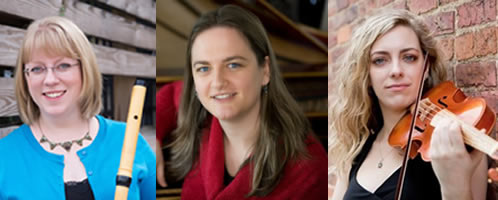Continuing the NC HIP Music Festival was the Raleigh Camerata in an evening of Baroque concertos. The brainchild of Suzanne Rousso, the artistic director of the Mallarmé Chamber Players, the festival means to introduce modern audiences to Baroque music the way it was originally intended to be heard; the 16 concerts in the month of February feature intimate programs, replicas of period instruments, and experts in their performance.
The Raleigh Camerata is, indeed, “the Triangle’s premiere Baroque ensemble,” shown in their wonderfully varied and delightfully executed performance on Saturday. Allison Willet stepped up first to lead Antonio Vivaldi’s Concerto No. 11 in D, Op. 4, RV 204, a bubbly dialogue between Jennifer Streeter on harpsichord, bass continuo, violins, and Willet. The concerto, nicknamed “La Stravaganza” for its use of unusual harmonic elements and unexpected passage structures, contrasts a rolling harpsichord line with bowed viola da gamba (Baroque cello) and plucked violone (Baroque double bass).
Arranged in an intimate semicircle, Willet led the three-movement work with poise and enthusiasm, despite some initial issues in settling their intonation. Artistic director Dr. Kelly Nivison later described how temperamental the organic gut strings of these instruments can be, even stretching out of tune during the course of a movement.
Willet was joined by Nivison on Baroque flute and Streeter, who got to take on a much more soloistic role in J.S. Bach’s Brandenburg Concerto No. 5 in D, BWV 1050. The first documented concerto with a solo keyboard part, it is speculated that Bach composed the harpsichord part for himself, or at least knowing that he would be the one to premiere it. That is completely conceivable once the complex and intricate harpsichord parts enter. In the first Allegro movement in particular, Streeter performed the dense and complex cadenza so expressively that the love and joy Bach had for the instrument was palpable. Soloists traded phrases and gestures deftly, contrasting in timbre but complementing each other as a trio throughout the Affetuoso movement, and then the rest of the orchestra inched its way back into the Allegro seamlessly to bring the piece to a close.
The final work was C.P.E. Bach’s Concerto for Flute in D minor, Wq. 22, during which all three featured artists performed, this time with Nivison as the soloist. She explained some of the challenges and interesting facts about the piece, including how it was composed while C.P.E. Bach was working for Frederick the Great, but that it is not remembered whether it was written for him or his flute teacher Johann Quantz, a legendary figure in the flute world. This next generation of Baroque stylings sounded almost explosive after the work of C.P.E.’s father, with full, lush strings playing an expansive range of notes and dynamics. Through a Baroque lens, there are many contrasts in the first Allegro, between major and minor, loud and soft, and high and low, yet the soloist is still very traditionally accompanied by the strings and the bass continuo with harpsichord. It is worth noting as well that there was an addition of the Baroque viola to this piece, further adding to the depth of harmonies.
Nivison’s work on the Baroque flute was stunning; she blended historical interpretation with modern energy and flair, giving the best possible combination of historically accurate performance and lively, enjoyable interpretation. As arguably the most accomplished Baroque flutist in the state, her technique on this tricky instrument was fluid and infallible, especially in the more virtuosic third movement. The second movement, in contrast, is full of lovely suspensions and sighing delays in resolution, releasing an outpour of emotion, but in a refined and Baroque sort of way – the refrain of the evening. Nivison had joked at the beginning that these particular pieces were chosen for the program because of their leaps forward in style and harmony, “but within the scope of Baroque idealism… so there are still rules.”
Even so, the music was transportive, indicative of a time when society had just as many rules as its music, yet still so pleasing all these centuries later. There is something to be said for sitting less than a hundred feet from the performers and hearing their daintily quiet instruments. The beautiful church sanctuary at Hayes Barton United Methodist reverberated just enough to propel the delicate layers together through the air. Surely this is the best way to appreciate Baroque music in its original splendor.
The NC HIP Festival continues over the next two weeks; there are still 10 performances that are absolutely not to be missed! See our calendar for details.











